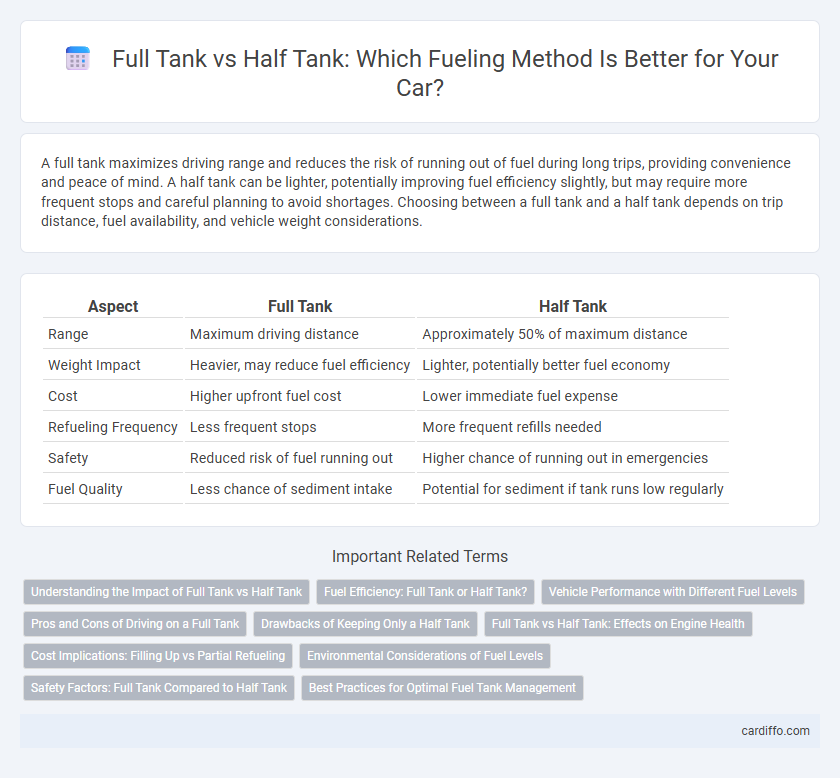A full tank maximizes driving range and reduces the risk of running out of fuel during long trips, providing convenience and peace of mind. A half tank can be lighter, potentially improving fuel efficiency slightly, but may require more frequent stops and careful planning to avoid shortages. Choosing between a full tank and a half tank depends on trip distance, fuel availability, and vehicle weight considerations.
Table of Comparison
| Aspect | Full Tank | Half Tank |
|---|---|---|
| Range | Maximum driving distance | Approximately 50% of maximum distance |
| Weight Impact | Heavier, may reduce fuel efficiency | Lighter, potentially better fuel economy |
| Cost | Higher upfront fuel cost | Lower immediate fuel expense |
| Refueling Frequency | Less frequent stops | More frequent refills needed |
| Safety | Reduced risk of fuel running out | Higher chance of running out in emergencies |
| Fuel Quality | Less chance of sediment intake | Potential for sediment if tank runs low regularly |
Understanding the Impact of Full Tank vs Half Tank
Driving with a full tank vs a half tank significantly impacts fuel efficiency and vehicle weight, affecting overall performance and fuel consumption. A full tank adds extra weight, potentially reducing miles per gallon, but prevents condensation buildup in the fuel system, which can extend engine life. Understanding these trade-offs helps drivers optimize fuel economy and vehicle maintenance.
Fuel Efficiency: Full Tank or Half Tank?
Fuel efficiency depends more on driving habits and vehicle maintenance than the fuel tank's fill level. A full tank increases vehicle weight slightly, causing minimal reduction in fuel economy compared to a half tank. Consistent engine tuning and smooth acceleration significantly impact overall fuel efficiency regardless of tank capacity.
Vehicle Performance with Different Fuel Levels
A vehicle's performance varies notably between a full tank and a half tank of fuel due to changes in weight and fuel delivery consistency. A full tank increases the car's overall weight, potentially reducing acceleration and fuel efficiency, while a half tank lightens the load, enhancing responsiveness and handling. Fuel system performance can also be affected; a full tank ensures a continuous fuel supply and reduces the risk of fuel pump overheating compared to lower fuel levels.
Pros and Cons of Driving on a Full Tank
Driving on a full tank offers the advantage of longer travel distances without the need for frequent refueling stops, enhancing convenience during long trips and reducing the risk of running out of fuel in remote areas. However, carrying a full tank increases vehicle weight, which can slightly reduce fuel efficiency and affect handling. The cost of filling up a full tank is higher upfront, but it may provide price stability by avoiding frequent purchases when fuel prices fluctuate.
Drawbacks of Keeping Only a Half Tank
Keeping only a half tank of fuel increases the risk of running out during unexpected detours or heavy traffic, potentially causing delays and safety hazards. Residual water and sediment in the fuel tank are more likely to cause clogging and corrosion when the tank is not kept full, leading to expensive repairs. Lower fuel levels can also result in increased fuel pump wear, as the pump relies on fuel for cooling and lubrication.
Full Tank vs Half Tank: Effects on Engine Health
Maintaining a full tank of fuel reduces the risk of sediment and moisture buildup in the fuel system, which can lead to corrosion and clogging when running on a half tank. A full tank helps ensure consistent fuel pressure, promoting optimal engine performance and longevity by preventing fuel pump overheating. Regularly keeping the tank full also minimizes the chance of fuel starvation during demanding driving conditions, protecting critical engine components.
Cost Implications: Filling Up vs Partial Refueling
Filling up a full tank often provides a lower cost per gallon due to bulk fuel pricing and fewer trips to the pump, reducing overall fuel expenses. Partial refueling or topping off a half tank can increase the frequency of fuel stops, leading to higher cumulative costs over time. Maintaining a full tank also helps avoid price volatility and potential surcharges associated with frequent small fuel purchases.
Environmental Considerations of Fuel Levels
Maintaining a full tank reduces the frequency of fuel stops, decreasing emissions generated by idling and acceleration during refueling. However, carrying a full tank increases vehicle weight, potentially lowering fuel efficiency and increasing carbon emissions over time. Balancing fuel levels to optimize weight and refueling frequency can minimize the vehicle's overall environmental impact.
Safety Factors: Full Tank Compared to Half Tank
A full tank provides a greater safety margin by reducing the risk of running out of fuel during emergencies or long trips, ensuring continuous engine operation and vehicle control. Full tanks also help prevent fuel pump overheating and potential damage, as fuel acts as a coolant for the pump, which is less effective at half tank levels. Maintaining a full tank minimizes condensation buildup inside the fuel tank, reducing the risk of corrosion and contamination that can compromise fuel system performance.
Best Practices for Optimal Fuel Tank Management
Maintaining a full tank reduces condensation buildup and fuel contamination, promoting engine efficiency and longevity. Partial fills increase the risk of moisture accumulation, leading to rust and fuel system corrosion over time. Optimal fuel tank management involves refueling before the tank drops below half to balance weight considerations with protection against fuel degradation.
Full Tank vs Half Tank Infographic

 cardiffo.com
cardiffo.com